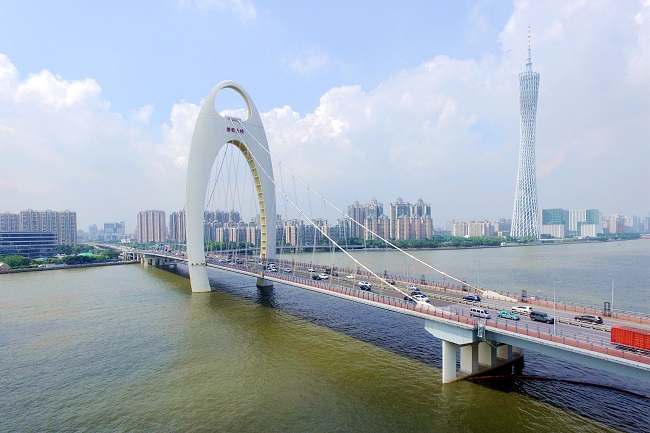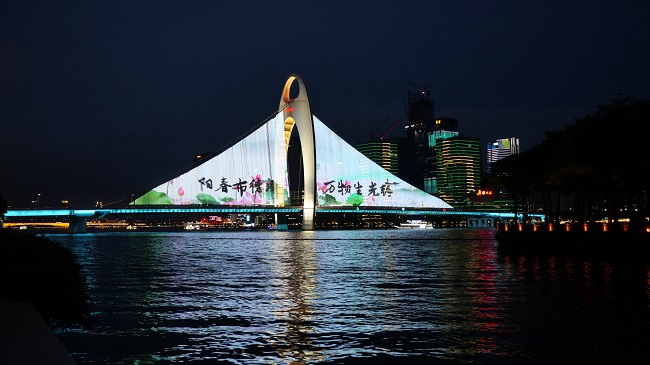Guangzhou Liede Bridge: A shining city landmark

The Liede Bridge
On November 9, 2024, as a significant component of the Guangzhou International Light Festival, the Guangzhou Liede Bridge showcased its unique charm and allure to countless visitors, solidifying its status as a beacon of the city.
Constructed by the CCCC Second Harbour Engineering Company, the Liede Bridge opened to traffic in July 2009. In April last year, after concluding his visit to China, French President Emmanuel Macron shared a video on social media of the dazzling light show on the Liede Bridge, expressing his admiration for Guangzhou in both Chinese and French. The video quickly went viral.
The Liede Bridge connects the Tianhe, Haizhu, and Panyu districts of Guangzhou, linking prominent landmarks such as the Tianhe Sports Center, Zhujiang New Town, and the Canton Tower. A key route into Guangzhou's central business district, the bridge is a landmark structure and the first cable-stayed bridge in the city. The northern end connects to Liede Road while the southern end intersects with Xingang East Road.
The bridge, a single-tower self-anchored cable-stayed structure, spans a total length of 4.3 kilometers, with the main span measuring 480 meters, featuring six lanes in each direction and is designed for speeds of up to 60 kilometers per hour.
The tower of the Liede Bridge stands at 128 meters, with the main structure rising to 103 meters. The tower's outer appearance consists of two shell-shaped curved shells interlocking with each other, presenting a novel and distinctive design. As one of the longest single-tower double-cable-plane self-anchored cable-stayed bridges in China at the time, the construction process posed three major technical challenges for the project team.

The Liede Bridge
Firstly, the construction of the tower was a key focal point and challenge of the entire bridge project, demanding remarkable engineering feats. With the tower standing at 128 meters in height, 56 meters in width and 9.16 meters in thickness, the precision required in the design and fabrication of the main tower formwork was exceptionally high. To ensure the shell-shaped curved appearance of the main tower, the three-dimensional curved surface formwork had to be meticulously crafted, with minimal margin for error. Moreover, the formwork was not reusable, resulting in significant cost outlay. From the design and fabrication stage to construction, the project team employed CNC technology to ensure precise and error-free construction.
The construction of the wide, unequal-span, and large-span stiffening girders presented another significant challenge. With a total length of 343.6 meters, a top width of 36.1 meters and a maximum span of 60 meters, the steel girders required meticulous control during the pushing process. To address the linear control issues during the pushing process, the project team collaborated with various research institutions, including Southwest Jiaotong University and the CCCC Wuhan Harbour Engineering Design & Research Co, forming a technical monitoring group to oversee and monitor construction around the clock. This ensured effective control of the tension and local pressure generated during the pushing process, guaranteeing the overall stability of construction and achieving remarkably precise results.
The installation of the three-dimensional self-anchored cable-stayed system posed a third construction challenge, with tasks such as the installation of the main cable saddle and spread cable saddle, manufacture and installation of cable clamps, system conversion construction, and precise length control of standard wires being critical points in the construction process. The high tower at the center of the bridge had to support two parallel long steel cable stays anchored at both ends of the bridge. These cables branched into 28 steel ropes, which in turn gripped various steel box girders on the bridge deck, transferring the pressure from the steel ropes to the cable stays and then to the anchors on the high tower and both ends of the bridge, supporting the entire structure.
To address these technical challenges, the project team conducted independent research and innovation on key technologies related to the shell-shaped arch bridge tower self-anchored cable-stayed bridge, resulting in one national invention patent and three utility model patents. The technologies encompassing the construction of the three-dimensional curved surface shell column, the wide, unequal-span, large-span steel girder pushing construction, and the installation of the three-dimensional curved surface self-anchored cable-stayed system were recognized by the Guangzhou New Technology Promotion Station, earning the "Four New" Achievement Certificate.
The tower's clear water concrete quality control team was also awarded the title of the Outstanding Quality Management Team of Anhui Province in 2008.
The Liede Bridge stands in stark contrast to the "Little Waist" Canton Tower, complementing each other from a distance. Affectionately referred to as the "Pearl of the Pearl River," the bridge's shell-shaped tower and curved cable stays combine to give the overall structure a sense of fluidity.
Together with other buildings that draw inspiration from marine-related forms, the bridge forms a series of dynamic spaces composed of flowing curves and surfaces, further enhancing the harmonious waterfront environment of Zhujiang New Town.









